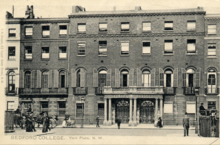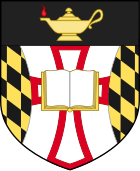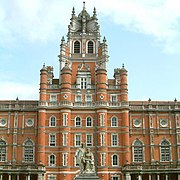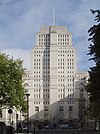Bedford College, London
| Bedford College | |
|---|---|
| University of London | |
 Bedford College was in York Place after 1874 | |
 Coat of arms | |
| Founder | Elizabeth Jesser Reid |
| Founded | 1849 |
| Closed | 1985 |
Bedford Collegewas founded in London in 1849 as the firsthigher educationcollege forwomenin the United Kingdom. In 1900, it became a constituent of theUniversity of London.Having played a leading role in the advancement of women in higher education and public life in general, it became fullycoeducational(i.e. open to men) in the 1960s. In 1985, Bedford College merged withRoyal Holloway College,another constituent of the University of London, to form Royal Holloway and Bedford New College. This remains the official name, but it is commonly calledRoyal Holloway, University of London(RHUL).
History[edit]
Foundation[edit]

The college was founded byElizabeth Jesser Reid(néeSturch) in 1849, a social reformer and anti-slavery activist, who had been left a private income by her late husband, Dr John Reid, which she used to patronise various philanthropic causes. Mrs Reid and her circle of well-educated friends believed firmly in the need to improve education for women.[1]She leased a house at 47Bedford Squarein theBloomsburyarea of London[2]and opened theLadies College in Bedford Square.[3]The intention was to provide a liberal, non-sectarian education for women, something no other institution in the United Kingdom provided at the time. Reid placed £1,500 (GBP) with three maletrusteesand persuaded a number of her friends to serve on the management committees and act as teaching professors.[4]In their first term they had 68 pupils.[5]
Initially the governance of the college was in the hands of the Ladies Committee (comprising some influential women) and the General Committee made up of the Ladies, the professors of the college and three trustees.[6]It was the first British institution partly directed by women.[1]The General Committee (later the council) soon took over the running of the college, while the Ladies Committee directed the work of the Lady Visitors, who were responsible for the welfare and discipline of the students, and acted as their chaperones.[2]Initially the professors were shocked by the generally low educational standards of the women entering the college, who in most cases had only home-basedgovernesseducation. In response, Reid foundedBedford College Schoolclose to the college in 1853, in an attempt to provide a better standard of entrants.[2]In 1860, the college expanded into 48 Bedford Square, which enabled it to become a residential establishment. "The Residence" was in the charge of a matron, who introduced the practice of students help to run the house and keep their own accounts.[2]
Succession[edit]
Elizabeth Reid died in 1866 and left a trust fund and the leases of the college's buildings in the hands of three female trusteesEliza Bostock,Jane MartineauandEleanor Smith.The three of them were concerned that Bedford College School was to become Anglican under the head, Francis Martin.[7]They closed the school although the idea went on without the trustees support as the Gower Street School being led, in time, byLucy Harrisonin 1875.[8]
The trustees insisted on a new constitution (as the college had no legal charter at the time). The council was replaced by a committee of management and the college reconstituted as an association under theBoard of Tradeand officially became known asBedford College.
In 1874, the Bedford Square lease expired and the college moved to 8 and 9 York Place, offBaker Street.Eliza Bostockwas still a trustee but many looked to her as honorary principal and with her knowledge of building and architecture she organised the college's move to York place.[9]The two houses, 8 and 9, acted as one, with the college using the downstairs rooms and the upstairs being the Residence. As numbers began to rise, the college expanded by adding extensions to house science laboratories. In the late 1870s, an entrance examination was introduced and a preparatory department set up for those who did not meet the standards required for college-level entry.
Women with degrees[edit]
In 1878, degree examinations of the University of London were opened to women. Bedford College students began gaining University of LondonBachelor of Arts,Bachelor of ScienceandMaster's degreesfrom the early 1880s. In 1891 the college began training women graduates to teach secondary students. In 1910Sara Melhuishwas appointed as the head of training and within five years there were sixty students and four specialist staff.[10]
In 1900, the University of London became ateaching university(before, it had only awardeduniversity degrees); Bedford College became one of its constituent colleges. It applied to thePrivy Councilfor aroyal charterto take the place of itsdeedofincorporation.Royal assentfor theuniversity charterwas received in 1909, and the college became officially recognised asBedford College for Women.
Continued growth led to a search for new premises, leading to the purchase of the lease on a site atRegent's Parkin 1908. A major fund-raising effort was undertaken to provide it with modern amenities. The purpose-built buildings were designed by the architectBasil Champneysand officially opened byQueen Maryin 1913.[11]The buildings continued to be extended and rebuilt throughout the 70 years that the college spent at Regent's Park, especially after extensive damage from wartime bombing.
The college colours were green and grey, said to be those ofMinerva.[12]Purple was added in 1938 to represent the university; the resulting colours were, by chance or design, similar to those of women'ssuffragein the United Kingdom.
A permanent record of the pictorial history of the college was made following the final reunion of former students and the collection and cataloguing of the archives in 1985.[13]
Bedford firsts include:[citation needed]
- First women to run a British institution.[1]
- First Social Sciences department in the UK, established 1918[citation needed]
- First woman to hold a chair in philosophy in the UK,Susan Stebbing.[14]
- One of the first two women fellows of theRoyal Society[15]
- Fourth woman chairman of theTrades Union Congress(TUC),Marie Patterson
- The first art school in England where women could draw from life[16]
After a brief period of admitting a small number of malepostgraduatestudents, the college became fully coeducational when 47 men passed throughclearingin 1965, and the name reverted toBedford College.
In the early 1980s, Bedford College had approximately 1,700 students and 200 academic staff based in 20 departments.
Merger with Royal Holloway[edit]
In 1985, Bedford College merged withRoyal Holloway College,another college of the University of London which, like Bedford College, had been a college only for women when first founded. The merged institution took Royal Holloway College's premises inEgham,Surrey,just outside London, as its main campus and took on the name of Royal Holloway and Bedford New College (RHBNC). The decision to drop the Bedford name from day-to-day use caused some discontent among graduates of Bedford College, who felt that their old college had now essentially been taken over by Royal Holloway, and that Bedford College's name and history as a pioneering institution in the field of women's education were being forgotten. To give more prominence to the Bedford name, the merged college named a large, newly built library in the centre of its campus the "Bedford Library". Relations between RHUL and some of the Bedford College alumni remain somewhat strained, but many other Bedford College alumni maintain links with RHUL, supporting alumni events and other college work.[citation needed]
Bedford College's old premises in Regent's Park is now the home ofRegent's University London.
Notable alumni[edit]
- Louise Doris Adams(died 1965), president of theMathematical Association
- Mary Bridges-Adams(1854–1939), English educationalist
- Shahidul Alam(born 1955), Bangladeshi photographer, writer and curator
- Chris Aldridge,EnglishBBC Radio 4newsreader
- Ajahn Amaro(born 1956), Theravadin Buddhist monk, and abbot of theAmaravati Buddhist Monastery
- Catherine Ashton(born 1956), High Representative of the Union for Foreign Affairs and Security Policy (European Union)
- Janet Backhouse(1938–2004), English expert on illuminated manuscripts
- David Bellamy(1933–2019), English botanist and television presenter
- Helen Caroline Bentwich(1892–1972), English social activist and politician
- Elizabeth Blackwell(1821–1910), pioneer Anglo-American female physician
- Daphne Blundell(1916–2004), British naval officer
- Joane Bowes, MBE(1911–1981), Biochemist D.Sc. for work in leather and collagen
- Mary Brazier(1904–1995), American neuroscientist
- Sophie Bryant(1850–1922), Anglo-Irish mathematician and feminist
- Anne Buck(1910–2005), British cultural historian and curator of dress
- Ada Buisson(1839–1866), English author and novelist
- Margaret Busby,Gold Coast-born publisher and writer
- Waveney Bushell,Guyanese-born educational psychologist
- Dinah Craik(1826–1887), English novelist and poet
- Ilse Crawford,English interior designer
- Florence Nightingale David(1909–1993), English and American statistician
- Evelyn Denington, Baroness Denington(1907–1998), English politician
- Peggy Duff(1910–1981), British political activist, organiser of theCampaign for Nuclear Disarmament
- Edith Durham(1863–1944), English traveller, artist and writer
- George Eliot(1819–1880), English novelist
- Christopher Elrington(1930–2009), English historian
- Susan E. Evans,English palaeontologist and herpetologist
- Penelope Farmer(born 1939), English children's novelist
- Mary Fels(1863–1953), German-born American philanthropist, suffragist, Georgist
- Dame Janet Finch(born 1946), EnglishVice-Chancellorand Professor of Social Relations atKeele University1995–2010
- Norvela Forster(1931–1993), English businesswoman and politician
- Jane Gardam(born 1928), English novelist and children's writer
- Miriam Violet Griffith(1911–1989) electrical engineer, technical author, expert in earlyheat pumps
- Jean Hanson(1919–1973), English biophysicist and zoologist
- Jean Henderson(1899–1997), English barrister and Liberal Party politician
- Jean Hillier,English town and country planning professor
- Edith Humphrey(1875–1978), English inorganic chemist
- Eva Ibbotson(née Wiesner, 1925–2010), Austro-English children's author
- Alison Jaggar(born 1942), Anglo-American philosopher and feminist professor
- Nick Kent(born 1951), English rock critic[17]
- Dudley Knowles(1947–2014), English political philosopher and professor
- Jean Langhorne,British biologist
- Judith Ledeboer(1901–1990), Dutch-English architect
- Alice Lee(1858–1939), English mathematician
- Kathleen Lonsdale(1903–1971), Anglo-Irish crystallographer
- Adelaide Manning(1828–1905), writer and editor
- Angela Mason(born 1944), English civil servant and gay activist
- Gerda Mayer(1927–2021), English poet born in Czechoslovakia
- John Moloney,English comedian and writer
- Delyth Morgan, Baroness Morgan of Drefelin(born 1961), English crossbench peer in the House of Lords
- Jeremy Northam(born 1961), English actor[18]
- Nicholas O'Shaughnessy,English communications professor
- Ursula Owen(born 1937), English publisher and campaigner for free expression
- Margaret Partridge(1891–1967), electrical engineer, contractor, founder member of theWomen's Engineering Societyand theElectrical Association for Women
- Delphine Parrott(1928–2016), English endocrinologist and immunologist
- Marie Patterson(born 1934), English trade unionist
- Edith Helen Paull(1902–1975), Indian nursing matron
- Kate Perugini(1839–1929), English painter and daughter ofCharles Dickens
- Rosalind Pitt-RiversFRS(1907–1990), English biochemist
- Jenny Randerson, Baroness Randerson(born 1948), Welsh Liberal Democrat member of the House of Lords
- Winifred Raphael(1898–1978), English occupational psychologist
- Hazel Alden Reason(1901–1976), English chemist and science writer
- Sarah Remond(1826–1894), African-American abolitionist, one of the few African-American women to speak publicly about abolishing slavery in America during the 1800s.[19]
- Jean Rook(1931–1991), English journalist
- Andrew Cunningham Scott(born 1952), English geologist and professor
- Joe Saward(born 1961), English motor-sports journalist
- Athene Seyler(1889–1990), English actress and a President of RADA
- Miranda Seymour(born 1948), English critic, novelist and biographer
- Jacqueline Simpson(born 1930), English researcher and writer on folklore
- Audrey Smith(1915–1981), English cryobiologist
- Roger Steare(born 1958), English ethicist and corporate philosopher
- Simon Thurley(born 1962), English architectural historian
- Mavis Tiller(1901–1989), New Zealand women's advocate, scientist and president of theNational Council of Women of New Zealandfrom 1966 to 1970
- Mary Treadgold(1910–2005), English novelist and children's writer
- Fred Trethewey(born 1949), Anglican priest andArchdeacon of Dudley
- Margaret Tuke(1862–1847), English academic and educator
- Sarah Tyacke(born 1945), English historian of cartography
- Valerie Vaz(born 1954), current Labour MP forWalsall South (UK Parliament constituency)
- Amanda Vickery(born 1962), English historian and broadcaster
- Diana Warwick, Baroness Warwick of Undercliffe(born 1945), Labour member of the House of Lords
- Evelyn Whitaker(1844–1929), English children's writer
- Alex Wilkie(born 1948), English mathematician
- Elizabeth Williams(1895–1986), English mathematician and educationist
- Katharine Worth(1922–2015), English drama professor
- Margaret Wright(1940–2012), BritishGreen Partypolitician
- Florence Yeldham(1877–1945), English school teacher andhistorian of arithmetic
- Alice Zimmern(1855–1939), English translator and suffragist
Principals[edit]
- Elizabeth Jesser Reid,Founder (1849–1864) thenrun by trusteesuntil first principal appointed
- Dame Emily Penrose,First principal (1893–1898) also Royal Holloway (1898–1907)
- Ethel Hurlbatt(1898–1906)
- Dame Margaret Jansen Tuke(1907–1929)
- Geraldine Emma May JebbCBE (1930–1951)
- Norah Lillian Penston(1951–1964)
- Elizabeth Millicent Chilver(1964–1971), later Principal ofLady Margaret Hall, Oxford
- John Nicholson Black(1971–1981)
- Dorothy Wedderburn,last Principal of Bedford College (1981–1985)
References[edit]
- ^abc"Reid [née Sturch], Elisabeth Jesser (1789–1866), slavery abolitionist and founder of Bedford College, London".Oxford Dictionary of National Biography(online ed.). Oxford University Press.doi:10.1093/ref:odnb/37888.(Subscription orUK public library membershiprequired.)
- ^abcd"Bedford College Papers".JISC Archives Hub.Retrieved3 February2021.
- ^Tuke 1939,p. 23.
- ^Raftery, Deirdre (1997).Women and Learning in English Writing, 1600-1900.Four Courts Press. p. 184.ISBN9781851823482.
- ^Cockburn, J. S.; King, H. P. F.; McDonnell, eds. (1969)."The University of London: The Constituent Colleges".A History of the County of Middlesex: Volume 1, Physique, Archaeology, Domesday, Ecclesiastical Organization, the Jews, Religious Houses, Education of Working Classes To 1870, Private Education From Sixteenth Century.London: Victoria County History. pp. 345–359.Retrieved19 February2021.
- ^Tuke 1939,p. 29.
- ^"UCL Bloomsbury Project".www.ucl.ac.uk.Retrieved8 April2020.
- ^"Harrison, Lucy (1844–1915), headmistress".Oxford Dictionary of National Biography(online ed.). Oxford University Press.doi:10.1093/ref:odnb/64670.(Subscription orUK public library membershiprequired.)
- ^"Bostock, Elizabeth Anne [Eliza] (1817–1898), promoter of women's education".Oxford Dictionary of National Biography(online ed.). Oxford University Press.doi:10.1093/ref:odnb/52743.(Subscription orUK public library membershiprequired.)
- ^Matthew, H. C. G.; Harrison, B., eds. (23 September 2004),"Sara Melhuish in The Oxford Dictionary of National Biography",The Oxford Dictionary of National Biography,Oxford: Oxford University Press, pp. ref:odnb/62413,doi:10.1093/ref:odnb/62413,retrieved9 April2023
- ^Saunders, Ann (1969).Regent's Park: A Study of the Development of the Area from 1086 to the Present Day.London: David & Charles. p. 160.ISBN9780715343937.
- ^"The BCUS Student Union Shop".Retrieved16 June2017.
- ^Bentley, Linna (1991).Educating Women A Pictorial History of Bedford College University of London 1849-1985.Surrey:Alma Publishers in conjunction with Royal Holloway and Bedford New College University of London.
- ^Chapman, Siobhan (2013).Susan Stebbing and the language of common sense.Basingstoke, Hampshire: Houndmills. p. 79.ISBN9780230302907.
- ^Hodgkin, D.M.C.(1975). "Kathleen Lonsdale (28 January 1903 – 1 April 1971)".Biographical Memoirs of Fellows of the Royal Society.21:447–26.doi:10.1098/rsbm.1975.0014.
- ^"Henrietta Busk".Amersham Museum.Retrieved8 April2020.
- ^"Faber & Faber: Apathy for the Devil [Nick Kent, 9780571232857]".Archived fromthe originalon 27 June 2010.Retrieved14 May2010.
- ^Royal Holloway, University of London.The Independent,27 July 2007. Retrieved 29 August 2008.
- ^"Pioneering women",Royal Holloway University of London.
Sources[edit]
Tuke, Margaret Janson (1939).A History of Bedford College for Women, 1849-1937.London: Oxford University Press.
External links[edit]
- History of Royal Holloway and Bedford New College
- Royal Holloway, University of London Archives
- Genesis website page on Bedford College's archived papersArchived5 February 2012 at theWayback Machine
- Genesis website page on Elizabeth Jesser Reid's archived papersArchived5 February 2012 at theWayback Machine
- Notable Alumnaewebpage of Royal Holloway and Bedford New College
- Bedford College student lists
- Bedford College in World Ward II,accessed 27 May 2012
- Bedford College, London
- Royal Holloway, University of London
- Former colleges of the University of London
- Former women's universities and colleges in the United Kingdom
- Universities and colleges established in 1849
- Educational institutions disestablished in 1985
- 1849 establishments in England
- Regent's Park
- Women in London


